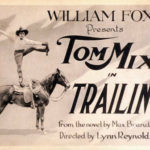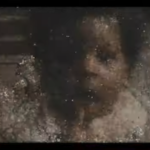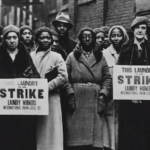Dubbing to Preserve Endangered Languages
By Peter Monaghan
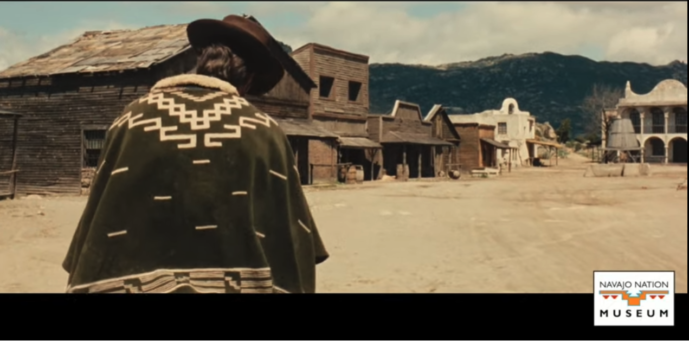
In surprising projects in Navajo country and in Australia, adaptations of hugely popular films into Indigenous languages are helping to preserve threatened languages, as well as to provide fresh perspectives on the films.
Late in 2021, the 1964 “spaghetti western” A Fistful of Dollars, starring Clint Eastwood as “The Man with No Name,” was added to that select group of adaptations. It appeared in the Navajo language as Béeso Dah Yiníłjaa’.
“Language preservation is at the core of it — language awareness and issues surrounding it,” said Manuelito (Manny) Wheeler, director of the Navajo Nation Museum in Window Rock, Arizona, who headed the project.
Wheeler said the adaptation project succeeded in more than entertaining a fully engaged audience; It also served a larger purpose of alerting viewers to the importance, and possibility, of preserving and propagating the now little-spoken Navajo language, Diné Bizaad, through film.
Every year Native American languages die out. Wheeler himself, although he was born and raised on the Navajo Nation, speaks regretfully of never being taught to speak Navajo.
Still, he said, one hopeful sign is that throughout the United States, there has been an upswing in Native entertainment, with movies and television programs that are focusing on Native people, and movies focusing on Native American people. “It just seems to be a trend, maybe,” he said.
The Navajo adaptation of Fistful of Dollars was the third such project. Over the last decade, the Navajo Nation Museum has worked with Lucasfilm on a Navajo Star Wars, and with Walt Disney Pictures and Deluxe Studios on a Navajo Finding Nemo.
Is it surprising that a Navajo organisation would promote a film from the western genre, hardly the most flattering or even-handed towards Native American people, over the decades?
Yes, and no, Wheeler said. The western genre is popular among Navajo and other Native American peoples. That’s likely because, often demeaning or not, westerns was the genre that many Navajo elders watched while attending off-Nation boarding schools. Many younger residents of the Navajo and other nations viewed the genre often on television, too.
A Fistful of Dollars has another plus, Wheeler said: the spaghetti western has no Native Americans, so no inaccurate and offensive depictions of them. Fistful of Dollars portrays a wandering gunfighter who resolves ugly fighting in a Mexican village by playing two rival families against the other.
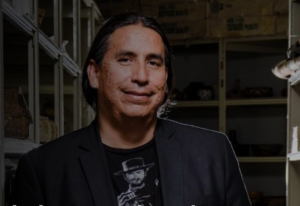
Manny Wheeler. Image: Arizona State University
“Westerns are really loved by our older generation, my father’s generation,” Wheeler said. “They love watching those old westerns.
“I’m sure there’s some psychology in that, as well,” he added.
“My father was born in the 1940s, just one generation away from people who were in conflict with the US. There has been a lot of talk about colonization. I’m still trying to understand what that really means.”
He said he believes that the older generation’s attachment to westerns stems in some part from “the attempt of my father’s generation to want to belong to America.”
With all that, he said, “the third movie we were going to put into Navajo, we knew it was going to be a western. Then it just came down to making a selection.”
Wheeler said he’s quite partial to the spaghetti westerns, himself. The genre’s leading director, Sergio Leone, was a master cinematographer who knew film history well, as occasional nods to the likes of Japanese master Akira Kurosawa attested.
In 2013, the Navajo Nation Museum prepared a similar treatment of Star Wars Episode IV: A New Hope. The Navajo version of that 1977 film was the first major motion picture to be translated into a Native American language.
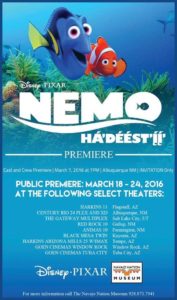 That required much work and persistence. Wheeler bought a Star Wars script in the mid-1990s and his wife, Jennifer Wheeler, who speaks Navajo fluently and has taught it at Arizona State University, quickly translated it.
That required much work and persistence. Wheeler bought a Star Wars script in the mid-1990s and his wife, Jennifer Wheeler, who speaks Navajo fluently and has taught it at Arizona State University, quickly translated it.
Getting Lucasfilm’s approval to go ahead was not as rapid. That took 16 years. Wheeler persistently asked Lucasfilm, then-owner of the movie, for approval to dub it into Diné Bizaad, and finally in 2012 received the OK. Lucasfilm even sent a dubbing expert, Shana Priesz, to the Navajo Nation to help. She recruited a director, Ellyn Epcar, and a film engineer to push the project ahead with Navajo voice actors Wheeler found and trained. Wheeler said: “Lucasfilm really put us in the good hands of the technology people they sent down. I and my other Navajo team members got a crash course in what quality dubbing is.”
Wheeler’s success in gaining approval, and in producing the dubbed version, led him to try again in 2013 with Finding Nemo. The Disney studio and Pixar Animation approved that project, and assisted the Navajo Nation Museum in completing it ahead of a 2016 release. (Wheeler described the first two projects and their purpose in a 2016 lecture preserved online.)
Wheeler said: “So Fistful of Dollars was really the first one we did on our own, still with a lot of studio support. We said to them: ‘We can do this,’ and if you, the studio, can quality check, that’d be great.”
At the first screenings of the film, a largely Navajo audience was “on the edge of their seats, talking to the movie as it was playing,” he said. “When it was over, everybody really started cheering and applauding.”
Several popular films have now been dubbed into Indigenous languages around the world. There’s an Arapaho Bambi and Dakota and Lakota versions of the animated Berenstain Bears series. There’s also a Maori (New Zealand) Moana and a Frozen 2 adapted into Sámi, the language of Finno-Ugric-speaking people of Sápmi and other parts of Scandinavia and northern Europe.
In Australia, Kylie and Clint Bracknell have a similar project that they say was inspired by the Navajo Star Wars. Their project is an adaptation of Fist of Fury into Noongar Daa, a threatened Indigenous language of south-west Western Australia.
Fist of Fury, also known as The Chinese Connection, is the 1972 film, set in 1930s Shanghai, that launched Bruce Lee to international fame.
Their project of creating a Fist of Fury Noongar Daa culminated in a premiere screening in 2021 at the Perth [West Australia] Festival, and then a tour through Noongar country as part of NAIDOC Week, an annual series of celebrations that recognize the history, culture, and achievements of Aboriginal and Torres Strait Islander peoples.
In an online Art Works feature about the project, Kylie Bracknell (Kaarljilba Kaardn), said the choice of the Bruce Lee film, and Fist of Fury specifically, was strategic. “Blackfellas love Bruce Lee, but they also saw the act of standing up, the little guys standing up against the colony, standing for justice, for what’s right,” she said.
As in the Navajo projects, the Noongar project had dual aims — not only to promote the Noongar language in an entertaining way, but to dub the film accurately in a way that was faithful to what they viewed as the film’s original themes.
Those, the Bracknells believed, had been obscured by English subtitling. They saw Fist of Fury as a response to and a lament about the ultimate futility of resistance to colonization, full of grieving but also a fierce drive for justice. They noted that such nuances were lost in the English-language dubbing of the original film from Cantonese, which made Bruce Lee’s character (Chen Zhen) appear driven primarily by vindictiveness and vengeance.
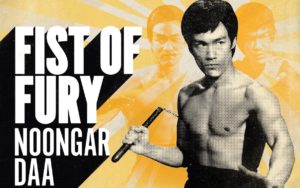
In translating the Cantonese to Noongar, they sought to recapture the humanity of Chen Zhen and other characters. So, they took great pains to match accurately not only the language of the original, but the timing of the dubbing. Their goal was to prevent the film descending into comedy. In an online Art Works feature about the project, Kylie Bracknell (Kaarljilba Kaardn), explained: “Once we got into the studio, to record with a voice cast, we would look at the footage, and to honor the on-screen performers, we would try to match their mouth movements as seamlessly as possible because we did not want this to be comedic in any way, shape, or form. We wanted to honor the original story.”
She said Bruce Lee was the first non-Anglo action hero actor Australian Aboriginal people saw on screen. And what they saw was familiar in a way that added to Lee’s appeal: “The physicality, I’ve always felt, is akin to the physicality of our athletes in a traditional setting, our hunter-gatherers who were ripped, and completely fit, and knew the terrain they were working with, and were agile, smart, and intelligent on the ground.”
Kylie Bracknell had previously produced a Noongar translation of Shakespeare’s Macbeth for Aboriginal theatre company Yirra Yaakin in 2020, but said she is not fluent in Noongar Daa, so called on a Noongar elder and artist, Roma Yibigung Winmar — “Auntie Roma” — to help the project team negotiate some of the linguistic challenges of translating from one language, and culture, to another.
She said she hopes the result will boost grassroots efforts to keep Noongar alive, efforts that greatly benefitted the film project: “There are so many Noongar families that have somehow — miraculously, I think — managed to keep our language strong enough to maintain its hum.”
Still, she said, only a very small percentage of Noongar people speak the language on any regular basis.
In both the Navajo and Noongar projects, translating the foreign-language originals – whether in Cantonese or English — raised challenges, including that the adaptations required finding words for concepts not found in the target languages. The Navajo adaptation of Finding Nemo, for example, required using Navajo words relating to rivers to handle the many ocean-related words in the original.
Both Bracknell and Wheeler spoke of the morale-boosting outcomes of their projects. Wheeler said he’s hearing of Navajo youth, in particular, expressing pride in their language after viewing the films. “That’s manifesting in social media and all sorts of forms,” he said. How effectual that pride will be in regenerating the Navajo language is as yet hard to guage, he said: “It’s hard to quantify that, right now. I don’t know whether we’ll ever be able to quantify it. Maybe 20 years from now, we’ll see an upsurge in the number of people speaking Navajo.”
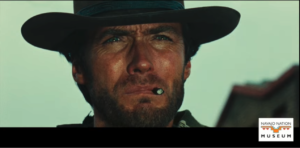 He said he’s optimistic, in that regard. Among Navajo people of all ages, from elders on down, pride and morale around language are blooming, he said. With that is coming greater understanding and readiness to discuss “how trauma has affected us, a historical trauma from what has happened, and been done to Native people by America.
He said he’s optimistic, in that regard. Among Navajo people of all ages, from elders on down, pride and morale around language are blooming, he said. With that is coming greater understanding and readiness to discuss “how trauma has affected us, a historical trauma from what has happened, and been done to Native people by America.
“There’s maybe been an attitude of ‘I’m OK, I’m OK’ but in reality there are deep wounds for us. And for us to participate in Star Wars really helps out morale.”
“It’s really important especially to our young people to feel that their culture and their being are important.”
The film projects also has economic benefits on the Navajo Nation, he said. The projects, if they continue, can create jobs. The Nation is certainly equipped to provide voice actors for many projects, he said: “We were really fortunate in the number of people who came out — over 160 people over two days came to audition for Star Wars. That paved the way and opened the doors. It opened a lot of mental doors. I’d never even thought about that.”
During the Finding Nemo adaptation project, many children unsurprisingly showed interest in taking part, so members of the Navajo Nation worked with them to help them to speak Navajo.
Said Wheeler: “Voice acting is something that didn’t even exist before. My hope and dream for us, the Navajo people, and for all Native people around the country, and Indigenous people around thw world, is that this is something that can be created out of our languages. There can be voice actors, and sounds engineers, and production companies that can be native owned. With Indigenous directors.
“So there can be totally an industry that is about to be created that surrounds film and our languages.”
Previous Post: 25 Films Chosen for National Film Registry

